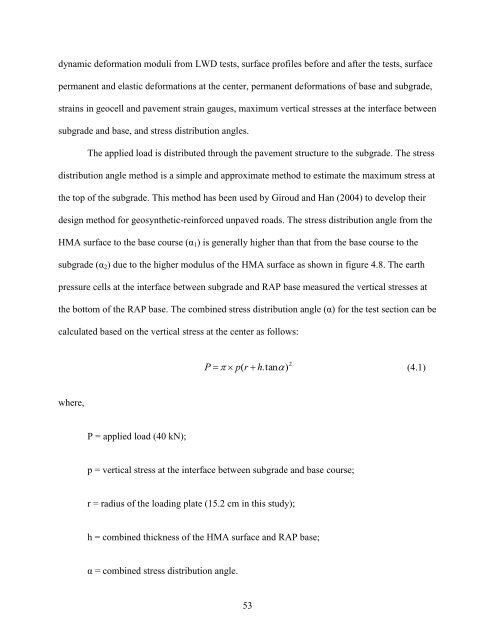Onsite Use of Recycled Asphalt Pavement Materials and Geocells to ...
Onsite Use of Recycled Asphalt Pavement Materials and Geocells to ...
Onsite Use of Recycled Asphalt Pavement Materials and Geocells to ...
You also want an ePaper? Increase the reach of your titles
YUMPU automatically turns print PDFs into web optimized ePapers that Google loves.
dynamic deformation moduli from LWD tests, surface pr<strong>of</strong>iles before <strong>and</strong> after the tests, surface<br />
permanent <strong>and</strong> elastic deformations at the center, permanent deformations <strong>of</strong> base <strong>and</strong> subgrade,<br />
strains in geocell <strong>and</strong> pavement strain gauges, maximum vertical stresses at the interface between<br />
subgrade <strong>and</strong> base, <strong>and</strong> stress distribution angles.<br />
The applied load is distributed through the pavement structure <strong>to</strong> the subgrade. The stress<br />
distribution angle method is a simple <strong>and</strong> approximate method <strong>to</strong> estimate the maximum stress at<br />
the <strong>to</strong>p <strong>of</strong> the subgrade. This method has been used by Giroud <strong>and</strong> Han (2004) <strong>to</strong> develop their<br />
design method for geosynthetic-reinforced unpaved roads. The stress distribution angle from the<br />
MA surface <strong>to</strong> the base course (α1) is generally higher than that from the base course <strong>to</strong> the<br />
subgrade (α2) due <strong>to</strong> the higher modulus <strong>of</strong> the HMA surface as shown in figure 4.8. The earth<br />
pressure cells at the interface between subgrade <strong>and</strong> RAP base measured the vertical stresses at<br />
the bot<strong>to</strong>m <strong>of</strong> the RAP base. The combined stress distribution angle (α) for the test section can be<br />
calculated based on the vertical stress at the center as follows:<br />
where,<br />
P = applied load (40 kN);<br />
P <br />
2<br />
p(<br />
r h.<br />
tan<br />
)<br />
(4.1)<br />
p = vertical stress at the interface between subgrade <strong>and</strong> base course;<br />
r = radius <strong>of</strong> the loading plate (15.2 cm in this study);<br />
h = combined thickness <strong>of</strong> the HMA surface <strong>and</strong> RAP base;<br />
α = combined stress distribution angle.<br />
53
















